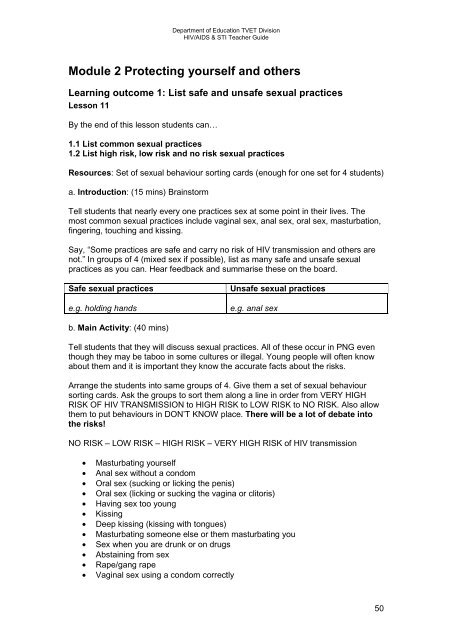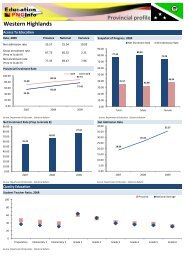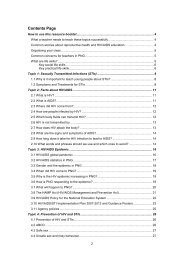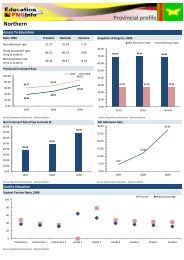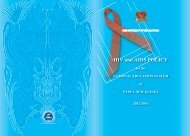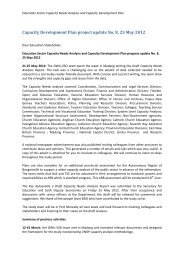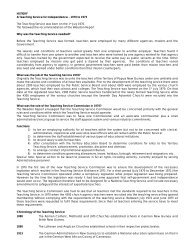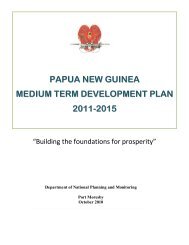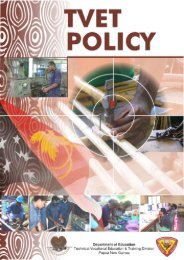Health Education to Prevent HIV/AIDS & STIs - Department of ...
Health Education to Prevent HIV/AIDS & STIs - Department of ...
Health Education to Prevent HIV/AIDS & STIs - Department of ...
Create successful ePaper yourself
Turn your PDF publications into a flip-book with our unique Google optimized e-Paper software.
<strong>Department</strong> <strong>of</strong> <strong>Education</strong> TVET Division<br />
<strong>HIV</strong>/<strong>AIDS</strong> & STI Teacher Guide<br />
Module 2 Protecting yourself and others<br />
Learning outcome 1: List safe and unsafe sexual practices<br />
Lesson 11<br />
By the end <strong>of</strong> this lesson students can…<br />
1.1 List common sexual practices<br />
1.2 List high risk, low risk and no risk sexual practices<br />
Resources: Set <strong>of</strong> sexual behaviour sorting cards (enough for one set for 4 students)<br />
a. Introduction: (15 mins) Brains<strong>to</strong>rm<br />
Tell students that nearly every one practices sex at some point in their lives. The<br />
most common sexual practices include vaginal sex, anal sex, oral sex, masturbation,<br />
fingering, <strong>to</strong>uching and kissing.<br />
Say, “Some practices are safe and carry no risk <strong>of</strong> <strong>HIV</strong> transmission and others are<br />
not.” In groups <strong>of</strong> 4 (mixed sex if possible), list as many safe and unsafe sexual<br />
practices as you can. Hear feedback and summarise these on the board.<br />
Safe sexual practices<br />
e.g. holding hands<br />
Unsafe sexual practices<br />
e.g. anal sex<br />
b. Main Activity: (40 mins)<br />
Tell students that they will discuss sexual practices. All <strong>of</strong> these occur in PNG even<br />
though they may be taboo in some cultures or illegal. Young people will <strong>of</strong>ten know<br />
about them and it is important they know the accurate facts about the risks.<br />
Arrange the students in<strong>to</strong> same groups <strong>of</strong> 4. Give them a set <strong>of</strong> sexual behaviour<br />
sorting cards. Ask the groups <strong>to</strong> sort them along a line in order from VERY HIGH<br />
RISK OF <strong>HIV</strong> TRANSMISSION <strong>to</strong> HIGH RISK <strong>to</strong> LOW RISK <strong>to</strong> NO RISK. Also allow<br />
them <strong>to</strong> put behaviours in DON’T KNOW place. There will be a lot <strong>of</strong> debate in<strong>to</strong><br />
the risks!<br />
NO RISK – LOW RISK – HIGH RISK – VERY HIGH RISK <strong>of</strong> <strong>HIV</strong> transmission<br />
• Masturbating yourself<br />
• Anal sex without a condom<br />
• Oral sex (sucking or licking the penis)<br />
• Oral sex (licking or sucking the vagina or cli<strong>to</strong>ris)<br />
• Having sex <strong>to</strong>o young<br />
• Kissing<br />
• Deep kissing (kissing with <strong>to</strong>ngues)<br />
• Masturbating someone else or them masturbating you<br />
• Sex when you are drunk or on drugs<br />
• Abstaining from sex<br />
• Rape/gang rape<br />
• Vaginal sex using a condom correctly<br />
50


